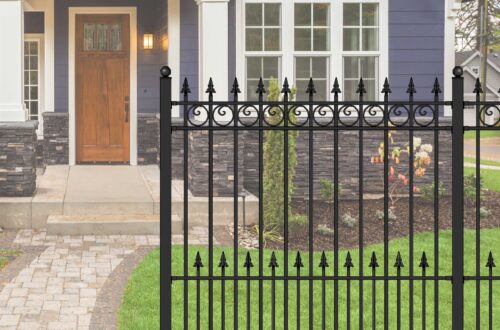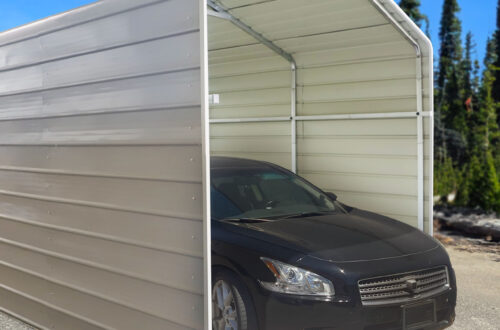When deciding on the right type of fencing to protect your property and home, metal fencing is the strong, secure choice. Wood becomes weathered quickly, while processed plastics are an eyesore from the get-go. Then there’s stone fencing, which is heavy, costly, and difficult to manage. Metal fences, on the other hand, are the Goldilocks solution—providing just the right amount of style, privacy, and security.
Different types of metal fencing offer distinct benefits, however. Whether it’s wrought iron, chain link, or aluminum, each metal comes with unique aesthetics, costs, and applications to weigh.
Which one is right for you? Set down the auger for a moment, and let’s break down the most common types of metal fences.
#1 Galvanized Steel Chain Link Fences
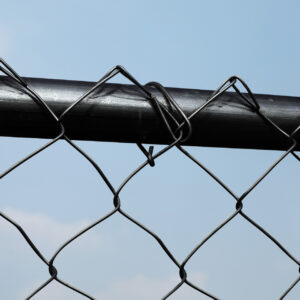
Steel chain link fences are the classic fortifications enclosing schoolyards, industrial buildings, and suburban homes alike. And they’re often what people think of when metal fences are brought into the discussion.
Chain link fence kits are a trusted choice for both commercial and residential purposes for their durability and value. Some specifics to keep in mind when considering installing it on your property include the following:
Appearance
Steel chain link fences are commonplace—you likely see them daily. Generally made of galvanized steel, they are erected in segments between sturdy, thick poles. Thinner steel wire is woven together in a mesh of small diamond shapes to create a wall, which is then stretched between the poles and secured to them. Chain link can be finished with paint or a chrome coat, but is mostly seen in standard steel gray.
Affordability
Chain link is amongst the most affordable of options to enclose plots of land, especially when dealing with large properties. Its woven design and thin gauge of metal mean it uses less raw material than heavier options like wrought iron styles. Large lengths can also be rolled for more efficient transport. These features result in one of the least expensive styles of fencing available.
Applications
In industrial settings where security is the primary concern, steel chain links can be built tall and topped with barbed wire.
In residential applications, keeping Rover in the yard or providing a boundary for kids’ playtime might be the main issue. Fences can be built shorter and affixed to buildings to easily conform to the needs of your household.
Specifications
Rolls of steel chain link fences are generally shipped in lengths of 50 feet. They’re usually 5 or 6 feet tall, with the possibility to double up and achieve 10 to 12 feet for industrial buildings. Poles are installed 10 feet apart with the wire mesh stretched tightly between them. Their sturdy structures are well-rated for longevity, with chain links having a 15 to 20-year life expectancy in most cases.
Pros and Cons
The most obvious pro of galvanized steel chain link fences is the price point. It’s the cheapest metal fencing material for enclosing your property. It’s fairly lightweight and straightforward to install, meaning the manual labor cost is also low—perfect if you’re going for function over aesthetics.
Some may take issue with the appearance of chain links when compared with other metal fencing options, but that said, beauty is in the eye of the beholder.
Another downside is that chain link fences are easier to scale than other styles. Furthermore, chain links can potentially be cut open with the proper tools and enough time. So, if you’re highly concerned about safety, you may want to consider wrought iron or aluminum.
Curious about how to install a chain link fence? Visit our blog for more information.

#2 Wrought Iron and Galvanized Steel
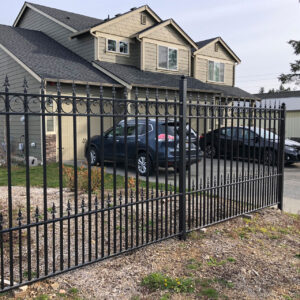
This classy companion to mansions and manors is one of the most popular types of metal fences, especially when it comes to aesthetics. Wrought iron has a reputation for being on the higher end of metal fence materials—it is what the Eiffel Tower is made out of, after all.
Realistically, however, wrought iron fencing comes in a variety of designs and a range of prices. Additionally, there are other types of metal fences made from galvanized steel that can give your home the same elegant look and feel at a more affordable price point. To decide if these fancy fences are right for your property, consider the factors below:
Appearance
Wrought iron is perhaps most renowned for the character it brings to homes. The thick, black steel rods that define this style offer formidable protection and contribute to the appearance of a property. The tips of wrought iron segments are usually capped with regal designs that look splendid and prevent climbing attempts. At ALEKO, you can select beautiful galvanized steel fences that provide the same appearance and style as a wrought-iron fence.
Affordability
Wrought iron is definitely not the easiest option on the wallet when it comes to metal fencing. There’s a reason it’s associated with high society. Dazzling fencing doesn’t have to be out of reach, however. If you find some sizzling deals, you can enclose your yard for less than you thought possible. You can also choose similar styles that are less expensive. ALEKO galvanized steel fences, for example, provide the same style as a wrought-iron fence, but at a more affordable price point.
Applications
Most frequently used in places that want a little flair with their security, wrought iron is the choice of city parks and churchyards alike. Segments can be installed to surround your property, with a matching gate blocking off your driveway for maximum security.
Specifications
Wrought iron is made of heavy gauge steel, which generally translates to heaviness.
With that in mind, you may be asking, “How much fence do I need?”
Metal fence panels vary in size, shape, and weight, but 6 to 8 feet is common for length and 4 to 5 feet normal for height. Wrought iron is a long-term investment, as its protective coating can keep it free from rust for upwards of 50 years. With minor fence maintenance, it can keep your estate secure for generations to come.
If you want to skip the price of wrought iron, discover our selection of wrought-iron-style fences made from galvanized steel.
Pros and Cons
Next, you may be wondering, how much does a fence cost? Cost is typically the primary setback of wrought iron. It’s also incredibly heavy, so installation can be more difficult when compared to fencing made of lighter materials.
That heavy frame makes it the most secure metal fence, however. It’s also particularly difficult to climb in relation to other types. Furthermore, unlike chain link, a pair of bolt cutters would barely dent the heavy-gauge steel. In terms of longevity, wrought iron will outlast essentially every other material on the market, making your initial cost a solid long-term investment.
#3 Aluminum Fencing
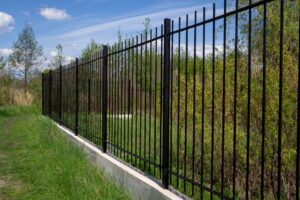
While aluminum fences might not be as well known as those made from other metals, they deserve recognition for their beauty and ease of installation.
In fact, some of the ornamental iron fences that you think are wrought iron might be aluminum in disguise. Aluminum fence material can be distinguished by its:
Appearance
While many aluminum fences are cast to look regal like wrought iron, some come as completely flattened panels. Aluminum metal panels offer a fencing solution for those craving supreme privacy. While it’s possible to drape a chain link or wrought iron fence panel with privacy fence screens, the opaque metal walls of aluminum paneling completely block prying eyes and dampen intrusive noises.
Affordability
While, in general, aluminum is cheaper to produce than steel, don’t expect to be saving a bundle versus installing wrought iron. Prices are generally in the same realm as the thicker, heavier gauge metal. If you’re looking to install specialty panels, expect prices to soar even higher—especially if you have them custom-made.
Applications
Aluminum fencing can be put up anywhere that other types, especially wrought iron, can be found. With a similar appearance, it will provide your property with the same visual appeal as the upscale material. Flat paneling is ideal for obscuring nosy neighbors, but it’s more vulnerable to wind than more aerodynamic designs. When deciding on your fence material, ensure you get something strong enough to withstand the weather in your area.
Specifications
Aluminum is a lightweight material in comparison to steel fencing, meaning your regular or privacy fence segments will be easier to lift and work with. They come in varying lengths and heights, similar to those of wrought iron. Aluminum’s ability to stand up to rust means you can get around 50 years out of an aluminum fence.
Pros and Cons
Aluminum panels present their own style that can complete your yard in a unique way. The material is lightweight, so installation is relatively easy in comparison to others. If you go with aluminum paneling, you can create a miniature fortress of solitude around the perimeter of your yard.
Unfortunately, aluminum’s light weight makes it less resistant to weather and not as secure as other forms of fencing. Though it boasts a solid lifespan, for a similar price, wrought iron will safeguard a home for centuries rather than decades.

Find the Perfect Fence to Protect Your Property With ALEKO
Along with budgets, looks, and functions, the quality of metal should be of the utmost concern when selecting a fence to fortify your home.
While choices such as style and material can be difficult, your choice of the supplier doesn’t have to be. ALEKO provides a wide variety of ready-to-install metal fence options, all of which have been powder-coated and galvanized to resist the elements; because fencing that stands up to the weather stands for longer.
Whether you’re after the prestigious touch a wrought-iron-style fence brings to property, or you’re looking for something simple to keep the dog contained to his corner of the yard, ALEKO has you covered. Plus, from gothic to modern, we have the style you need.
Trust ALEKO to keep your home and your peace of mind secure. Contact us today!
Sources:
Wisconsin Department of Transportation. Chain Link Fence. https://wisconsindot.gov/
San Francisco Gate. How Long Will a Vinyl-coated Chain Link Fence Last?. https://homeguides.sfgate.com
National Library of Medicine. Young children’s ability to climb fences. https://pubmed.ncbi.nlm.nih.gov/
The Metropolitan Museum of Art. The Making of Wrought Iron, 1928. https://www.metmuseum.org/
National Library of Medicine. The Influence of Hot-Dip Galvanizing on the Mechanical Properties of High-Strength Steels. https://www.ncbi.nlm.nih.gov/
National Library of Medicine. Young children’s ability to climb fences. https://pubmed.ncbi.nlm.nih.gov/
National Library of Medicine. Review on metal packaging: materials, forms, food applications, safety and recyclability. https://www.ncbi.nlm.nih.gov/
Home Advisor. Fencing. https://www.homeadvisor.com/
Home Garden Guides. How Long Does a Fence Last? (Wood, Aluminum, PVC, Vinyl). https://homegardenguides.com/fencing/how-long-does-a-fence-last/




